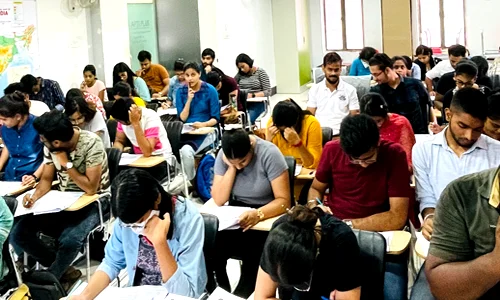



reduction in United States interest rates reshapes global capital movements and directly influences India’s financial landscape. Lower United States yields make emerging markets more attractive, potentially boosting foreign investment, easing borrowing conditions, and supporting growth through cheaper imports and improved liquidity. However, these benefits come with risks such as currency volatility, uncertain capital flows, export pressures, and inflationary spillovers. India must balance global monetary easing with domestic priorities—maintaining financial stability, strengthening structural reforms, and ensuring prudent macroeconomic management—to fully leverage opportunities while mitigating vulnerabilities.
Click to View MoreIndia’s childcare workers, despite supporting 23 million children through 1.4 million Anganwadis, remain undervalued, poorly paid, and inadequately supported. With rising care needs due to migration, climate stress, and women’s workforce participation, India must professionalise its childcare workforce, expand infrastructure, increase investment to 1–1.5% of GDP, and strengthen ICDS and crèche schemes. Recognising childcare as a critical component of human development is essential for building an inclusive, gender-just nation.
Click to View MoreThe Mahatma Gandhi National Rural Employment Guarantee Act (MGNREGA) aims to enhance livelihood security in rural India by guaranteeing at least 100 days of wage employment annually to rural households willing to perform unskilled manual work. The scheme emphasizes inclusion, with at least one-third of beneficiaries being women, and mandates timely wage payments with legal entitlements for unemployment allowances if work is not provided within 15 days of demand. MGNREGA supports sustainable rural development through asset creation such as water conservation, drought proofing, irrigation, and rural infrastructure. The Act strengthens decentralized planning through Panchayati Raj Institutions and encourages transparency via social audits.
Click to View MoreThe Sixteenth Finance Commission, chaired by Arvind Panagariya, submitted its 2026–31 report to the President after wide consultations. Formed under Article 280, it reviews Union and State finances, recommends devolution, grants, and disaster funding. It will be in public, once presented in the Parliament under Article 281.
Click to View MoreIndia has revised royalty rates for graphite, caesium, rubidium and zirconium to stimulate domestic exploration and reduce dependence on imported critical minerals vital for clean energy, electronics and strategic sectors. The shift to ad valorem royalties and the lowering of high default rates aim to attract more bidders and improve mining viability. However, despite these reforms, India continues to face deeper challenges such as weak exploration capacity, limited processing infrastructure, low private participation and heavy reliance on global supply chains. Royalty rationalisation is a step forward, but comprehensive reforms across mining, processing and technology ecosystems are essential for true mineral self-reliance.
Click to View More
The Draft Seeds Bill, 2025 replaces the 1966 Act, makes seed registration mandatory, adds a traceability portal, and sets penalties up to ₹30 lakh while easing minor offences. Farmer groups oppose it, citing a pro-corporate tilt, weak compensation provisions, and excessive central control that affects farmer rights.
Click to View MoreRetail inflation in India fell to a historic low of 0.25% in October 2025, primarily due to GST rate cuts, a favourable base effect, and a decline in prices of key food items such as vegetables, fruits, oils, and eggs. While food and beverage prices contracted, most other categories, including fuel, housing, and miscellaneous goods, saw higher inflation compared to last year. The decline provides short-term relief to households and businesses, stabilizes macroeconomic conditions, and supports policy measures aimed at economic growth and price stability.
Click to View MoreThe Credit Guarantee Scheme for Exporters is a government initiative providing collateral-free credit support of up to twenty thousand crore rupees to Indian exporters, including micro, small, and medium enterprises. By offering a 100% government-backed credit guarantee, the scheme enhances liquidity, promotes market diversification, strengthens global competitiveness, and supports employment. It aims to facilitate export-led growth, enable smoother business operations, and contribute to India’s journey towards becoming a self-reliant economy.
Click to View MoreQuality Control Orders (QCOs) in India, intended to improve product quality, have largely targeted raw materials and intermediate goods rather than finished products. This has increased input costs, disrupted supply chains, and reduced trade competitiveness, particularly affecting MSMEs. Imports of critical inputs have fallen, exports have seen short-term gains but long-term decline, and domestic suppliers have gained market concentration advantages. Aligning QCOs with global standards, focusing on finished goods, strengthening testing infrastructure, and supporting MSMEs are key steps to mitigate these challenges.
Click to View MoreUrban unemployment in India, particularly among youth and women, reflects structural, demographic, and skill-related challenges. Addressing it requires a holistic approach: enhancing skills, promoting formal and inclusive jobs, supporting entrepreneurship, leveraging technology, and integrating employment into urban planning. With targeted policies and continuous monitoring, cities can transform rising joblessness into sustainable economic growth.
Click to View MoreThe Central Pay Commission (CPC) is an expert body set up by the Government of India to review and recommend changes in the salaries, allowances, and pensions of central government employees and defense personnel. While it ensures fairness and equity in public sector compensation, CPC recommendations often pose fiscal challenges due to their impact on government expenditure. Key issues include infrequent revisions, weak links between pay and performance, and disparities across services and states. Future reforms suggest establishing a permanent pay review body, introducing performance-linked pay, and aligning revisions with fiscal sustainability. Overall, the CPC plays a crucial role in balancing employee welfare, administrative efficiency, and fiscal discipline in India.
Click to View MoreIn October 2025, India’s Goods and Services Tax collections reached ₹1,95,936 crore, up 4.6% from the previous year, partly due to festive spending. GST, introduced in 2017, replaced multiple indirect taxes to create a unified system. While industrialized states like Maharashtra, Karnataka, Gujarat, Tamil Nadu, and Haryana contributed over 40% of revenue, 20 states saw declines compared to pre-GST levels. Analysis shows that overall GST revenue remains lower than pre-GST taxes, with states like Mizoram and Nagaland improving collections, while Punjab, Chhattisgarh, Karnataka, Madhya Pradesh, and Odisha experienced significant drops.
Click to View More
© 2025 iasgyan. All right reserved